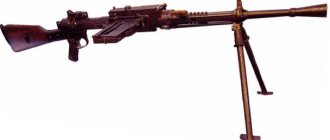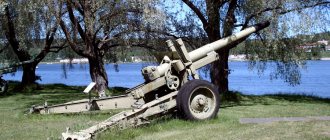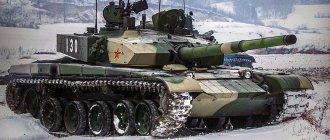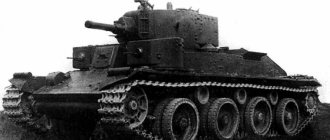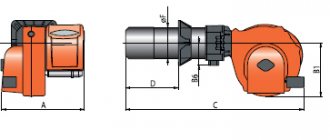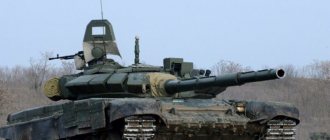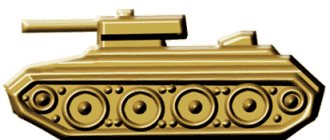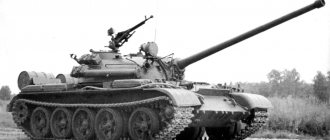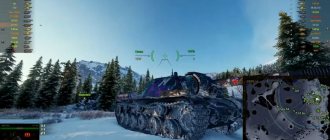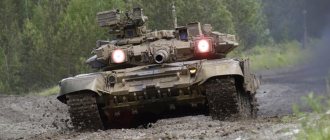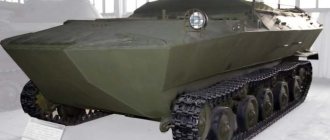I invite you to get acquainted once again with the history of the creation of one of the famous main tanks of our time - Abrams ("Abrams"), get acquainted with the history of its creation and with the modifications of the combat vehicle that are in service with the armies of some states.
If we consider the point of view of American researchers and chroniclers of the history of the creation of the Abrams main tank (OT), then some of them present the history of this vehicle as a further development of the M48 Patton II medium tank. This is exactly how the history of the creation of a new American OT is interpreted in the work of the American researcher R. Hunnicutt (RR Hunnicutt) “A History of the American main battle tank”.
Research work to develop a project for a new American tank began in 1951. In fact, the birth of the famous Abrams resulted in the consistent implementation of three main programs to develop the tank of the future.
The first of these was a program to develop the T95 tank, which was based on earlier work on the creation of an experimental T42 tank. The purpose of this R&D was to create a prototype vehicle with a relatively low mass, armed with a medium-caliber cannon. In parallel with the development of the T95, another program was initially developed - the T96, which provided for the development of a tank with heavy cannon armament.
Later, both projects were combined based on the T95 tank chassis. As part of this R&D, a total of 13 vehicle projects were developed, starting with T95 and ending with T95E12, as well as T96. However, the development of the T95EZ project was completely completed; all other versions were partially built or existed only in the form of mock-ups. When developing the T95 program, many innovations and concepts were developed, such as the use of a rigidly mounted smoothbore gun and new fire control systems.
Many of the concepts developed at that time require further development at the present time. These difficulties encountered, combined with the changing views of the military on the concept of the tank of the future, led to the closure of the T95 program. Instead, a program to improve the M48 Patton medium tank was urgently initiated. Such a rush was caused by the appearance in the USSR of medium tanks T-45A and T-54B, armed with a stabilized 100-mm cannon and superior in all characteristics to the American medium tanks M48 “Patton”. As a result of work to improve the M48 in the United States in 1960, the M60 tank with a 105-mm rifled gun was adopted.
The second prototype of the T95 tank with a 90 mm cannon at Fort Knox
Tests of the 120-mm Delta gun installed on the first prototype of the T95E8 tank with registration number 967052
Chassis of the T95E1 tank, on which a model of the turret is installed, a tank that will become a new prototype - MVT70
The second prototype of the MVT70 tank with registration number 09A002 67
A prototype of the XM803 tank with a 152 mm gun-launcher
A prototype of the XM1 tank with registration number JEOOO during competitive testing
Prototype of the XM1 tank
The first prototype of the XM1 tank at the Detroit plant in February 1978. Second from left is Dr. Philip Lett
The first production M1 Abrams tank, built at the Detroit plant. March 31, 1982
After the closure of the T95 program, the development of some new systems and components still continued. Everyone understood that sooner or later a new program would be launched in the United States to develop a promising main tank, new basic concepts of a battle tank. At the same time, in the USA and some NATO countries, the emphasis in the development of the main weapon of the tank changed somewhat.
The military's attention was no longer drawn to tank guns firing high-speed armor-piercing kinetic projectiles, but to gun-launchers capable of firing guided missiles with a cumulative warhead. A laser rangefinder and other new components for the fire control system appeared as technical innovations that could be used to create new tanks.
On August 1, 1963, an agreement was signed between the United States of America and the Federal Republic of Germany to jointly develop a new main tank for production and use in both countries. The project was named MBT70 - “Main Battle Tank 70”.
In the MVT70, the designers implemented many technical innovations, such as hydropneumatic suspension, an automated fire control system, automatic gun loading, and combined armor. It should be noted that similar armor and automatic loading in the USSR by this time had already been implemented on the mass-produced T-64 and T-64A tanks. So American designers, without even knowing it, played the role of “catching up” in the world tank building.
The introduction of advanced technical innovations in the MVT70 also led to an increase in the cost of the combat vehicle. The US Congress has revised a number of programs for the development of advanced technology in the direction of reducing the final cost of samples. The MVT70 program was also not included here. The promising tank was considered too expensive and complicated. In addition, there were many disagreements among American and German designers regarding the need and design of a number of systems and components of a promising tank. This led to the cessation of joint work on the car and each country went its own way.
In the United States, in order to reduce costs and increase reliability, the design of the promising tank was simplified, but the 152-mm gun-launcher was retained as the main weapon in the new project, designated the XM803 main tank. However, in the West, by the beginning of the 70s of the last century, priorities regarding the main weapon of the tank began to change again. Again, preference began to be given to guns capable of delivering fire with high-velocity armor-piercing kinetic projectiles. In addition, the new XM803 tank being developed was not much cheaper than its predecessor MVT70.
In December 1971, the US Congress terminated work on the XM803 project. At the same time, the need to develop a new tank for the army was recognized. The necessary funding was also allocated for this. We must not forget that the USSR was already armed with the T-64A medium tanks, armed with a 125-mm smoothbore tank gun capable of firing armor-piercing sub-caliber shells with an initial speed of 1800 m/s. New vehicles were on the way: T-72 Ural and T-80.
The “go-ahead” and funding from the US Congress for the development of a new American tank became the third attempt to create a new American tank, which was successful.
A working group was organized in the US Army to develop specifications for a new tank. The development of the TTZ for the tank of the 80s, designated XM1, began in January 1972. The TTZ prepared by the Ministry of Defense proposed using developments on the MVT70 and XM803. However, many uncertainties remained and there was even a moment when the option of abandoning the XM1 program in favor of further improving the M60 was considered.
The final requirements for the new tank and the timing of the program were formulated in January 1973. Most of all, when developing the TTZ, the financial side of the issue was taken into account, which limited the cost of one production vehicle to just over 500 thousand USD when ordering 3,300 tanks. For the first time in the United States, Chrysler Corporation decided to develop a new tank on a competitive basis.
The XM1 development program included three stages: 1974-76. – evaluation of the concept and selection of a prototype based on the results of comparative tests of prototypes and Chrysler; 1977-80 – finalization of the prototype, preparation of serial production, production of the pilot batch, acceptance into service; 1981-90 – serial production and modernization. The Pentagon transferred the TTZ and signed contracts with Chrysler Corporation for the development and creation of prototypes of the tank in June 1973.
True, in October some provisions of the TTZ had to be adjusted after a thorough analysis of the experience of the Arab-Israeli “Doomsday” war. This experience required increasing the effective range of fire against armored targets, increasing the ammunition load of the main weapon, enhancing the vehicle's security, reducing the time to prepare the vehicle for combat use, increasing the reliability of systems and assemblies and their maintainability.
One of the most controversial issues in the development of the new American main tank was the choice of the main weapon. At that time, USSR tanks already had 125-mm smoothbore guns; the new Leopard 2 tank being created in Germany was planned to be equipped with a 120-mm gun created in Germany. Why did the M1 Abrams go into service in the United States with the 105-mm M68 cannon (a licensed version of the British L7 cannon, developed in the second half of the 50s)?
The answer to this question was given to the author personally by the chief designer of the Abrams, Dr. Philippe Lei, during one of the meetings in Nizhny Tagil. It was he who proposed installing on the new tank a 120-mm Rheinmetall L44 smoothbore gun, developed in Germany for the new Leopard. And the American military insisted on the 105-mm M68 cannon, justifying their choice very simply: “there is a large amount of ammunition for the M68 cannon in warehouses, they need to be put somewhere. Then we’ll get back to talking about the 120 mm gun.”
Tank XM1 on display at the War Museum in Aberdeen
To participate in comparative tests, prototypes of the XM1 tanks were presented by competing companies in February 1976. Both tanks had a classic layout: a control compartment in the bow of the vehicle hull, a fighting compartment in the middle part of the hull, and a motor-transmission compartment in the stern. Tower with a cannon of circular rotation.
The power plant was a V-shaped diesel “Teledyne Continental” AVCR-1360-2 air-cooled with turbocharging, developing a power of 1500 hp. This engine is an improved version of the diesel engine used on the MVT70 and XM803 prototypes.
The vehicle presented was equipped with a three-shaft gas turbine engine “AVCO Lycoming” AGT-1500? Also with a power of 1500 hp.
The chassis of competing tanks also had differences. On the tank, the chassis consisted of six road wheels per side, three of which were on hydropneumatic suspension, and three on torsion bar suspension. On the Chrysler car, the chassis had seven road wheels per side with an individual torsion bar suspension.
In terms of weight, both prototypes fit into the TTZ and did not exceed 53 tons. Tests of prototypes of competing companies were carried out at the Aberdeen Proving Ground (Maryland), and then at Fort Knox and Fort Hood. The winner of the competition was determined on November 12, 1976. It was the prototype, which was selected by the leadership of the US Army for further development as the future main tank of the US Army.
M1 Abrams tank during Operation Desert Storm in February 1991. To enhance protection, tank crews hung sandbags on the armor
At the same time, attempts to cooperate with German designers to create a single main tank were resumed to a certain extent. On December 11, 1976, a memorandum of understanding in the field of tank building was signed between the United States and Germany. The document provided for comparative tests of the Leopard 2 and XM1 tanks in the United States and the adoption of the vehicle that would win these tests. The winner was to be determined by a joint commission consisting of specialists from the USA and Germany. At the same time, the Germans were skeptical about the gas turbine engine of the American car, and the American military on the Leopard did not like the weapon system with a 120-mm smoothbore gun.
Ultimately, economic problems became the stumbling block in choosing a single combat vehicle. As often happens, American and German manufacturing companies did not agree on the amount of profit received during the implementation of the project. As a result, the US armed forces and the Bundeswehr received different vehicles. Attempts to unify tanks by individual systems and units, such as the main weapon, power plant, chassis, did not lead to success.
The Military Commission of the US Congress insisted that work on maximum unification of components and systems would lead to a delay in the implementation of the program, its increase in cost and a decrease in the characteristics of the XM1 tank. In 1978, after the Americans refused to test the XM1 tank with a German diesel engine, the memorandum of understanding sank into oblivion.
To continue testing, it built 11 prototypes of the XM1 tank, which took part in the second stage of technical and military tests that took place from March 1978 to September 1979 and from May 1978 to February 1979, respectively.
Even before the completion of the second stage at the end of 1978, Chrysler received the go-ahead from the Pentagon to build an pilot batch of 110 tanks intended to participate in tests of the third stage and for training personnel of tank units.
American tank "Abrams" M1A2
During the tests, as one would expect when a fundamentally new machine is tested, a number of shortcomings were identified in the design of the machine and the operation of its systems and assemblies. Serious complaints were caused by the unreliable operation of the gas turbine power unit (GTSU). The gas turbine unit worked so unreliably that the average time between failures of the gas turbine engine was no more than 210 km. In this regard, it was even proposed to replace the gas turbine engine with a German diesel engine from “Leopard 2” or a British diesel engine “Rolls Royce” CV12. Engineers quickly had to carry out a whole range of work to improve the experimental machines, which had a positive effect.
During tests that were carried out in the second half of 1979, the modernized prototypes reached an average time between failures of the gas turbine engine of about 480 km. A number of representatives of the state commission for testing the XM1 insisted on delaying the adoption of the tank and the start of its mass production, proposing that engineers begin full-scale development of a diesel version of the XM1 tank.
However, most experts were in favor of using a GTSU on the tank as a more progressive technical solution. The last third stage of testing of the XM1 tank was completed in 1980 and the tank was put into service under the designation M1 "Abrams" in honor of General Creighton Abrams, the former Chief of Staff of the US Army, who commanded American troops in Vietnam during the final stage of that war. war.
The Pentagon placed an order for the construction of the first batch of 352 production tanks (vehicles). The first production M1 Abrams tanks were manufactured in 1980 at the state tank plant in Lima, Ohio, but mass full-scale production of these vehicles began only in September 1981. In 1982, serial production of Abrams started in one state tank plant - the Detroit Arsenal in Warren (Michigan). The total production rate for the two factories was 70 tanks per month.
A total of 2,374 Abrams tanks of the M1 modification were built, the production of which was completely discontinued in January 1985. By this time, it was in service with the USSR Ground Forces, including in groups of troops stationed in the GDR, Czechoslovakia, Poland and Hungary, as well as in In the Western military districts, there were already thousands of tanks of the T-64B, T-80B and T-72A types, which in terms of their characteristics significantly exceeded the latest American tank. And at Soviet research sites, tests of even newer models of armored weapons were nearing completion.
Did not show outstanding fighting qualities
The M1 Abrams' baptism of fire took place in 1991 during Operation Desert Storm. In this conflict, the United States lost about 20 of these vehicles. They were destroyed by "friendly fire" and T-72 tanks of the Iraqi army. Some vehicles were hit by hand grenade launchers or blown up by landmines.
The United States used the M1 Abrams in the 2003 Iraq War and operations in Afghanistan from 2001-2014. Various modifications of the tank are in service with Iraq, Egypt, Saudi Arabia, Kuwait and Australia. According to Murakhovsky, the M1 Abrams did not show outstanding combat qualities in the Middle East and was unable to gain great popularity abroad.
- M1 Abrams tanks
“I can’t say that this is an unsuccessful tank. I can attribute the lack of major achievements on the battlefield primarily to the lack of professionalism of the crews and the command’s mistakes in the tactics of using the M1 Abrams. This machine does not fight without the support of other forces and means,” Murakhovsky noted.
According to him, the M1 Abrams is inferior to Russian cars in key qualities - reliability and unpretentiousness.
Description of the design of the M1 Abrams tank
The main tank M1 "Abrams" is made according to the classic layout. The tank hull is a welded structure with a large angle of inclination of the upper frontal armored part (VLB). In the bow of the hull there is a control compartment located along the longitudinal axis of the machine.
The driver's workplace has a height-adjustable seat with soft upholstery, a headrest and lumbar support. In order to reduce the silhouette of the tank, in the combat position the driver takes a reclining position with his legs raised relative to the seat.
This is approximately how the Abrams driver controls the car when driving in combat mode
To control the movement of the tank, a T-shaped motorcycle-type steering column and a brake pedal are installed in the control compartment. All the necessary controls - reverse and forward gear selector, fuel regulator - are located on the steering column. The driver can get on and off his workplace only through a hatch equipped in the VLB, which is closed by an armored cover that slides to the right. There is no emergency hatch in the bottom of the hull. Three periscopic observation devices are installed in the driver's hatch cover.
The fighting compartment of the tank includes the middle part of the hull and a circular rotation turret. The fighting compartment houses the tank's weapons complex, communications equipment, commander, gunner and loader workstations, as well as other equipment.
On-board air conditioning
Another enhancement to the M1A2 SEP is the TMS thermal management system, which maintains crew compartment temperatures below 35°C and electronics temperatures below 52°C in extreme conditions. This increases the combat effectiveness of the team and the vehicle. The TMS consists of an AHU air handling unit and a VCSU vapor compression unit, which provide 7.5 kW of cooling capacity for the crew and quick-change LRUs. The AHU is installed in the rear of the turret and the VCSU is installed in front of the gunner's main sight. TMS uses environmentally friendly refrigerant R134a and a mixture of propylene glycol and water. The TMS is installed on the left side of the turret compartment and weighs 174 kg.
Comparison of the overall dimensions of the side projections of the American M1A1 and the Soviet T-72A
When creating the M1 Abrams tank, attention was paid to significantly increasing its security compared to tanks of previous generations. This problem was solved by reducing the silhouette of the tank and reducing its visibility, increasing armor protection, and using a new type of armor. The tank's hull and turret are all-welded. On the bow of the hull there are units for hanging roller or knife mine trawls, as well as bulldozer equipment.
The tower consists of outer and inner layers of armor steel, connected by transverse stiffeners, between which are filled with filler packs made of steel and ceramic materials. The chassis is covered with side screens consisting of separate sections of seven pieces per side. The sections have spaced armor, between which there is a filler. The screens are attached to the body on brackets using hinges, and the sections are connected to each other by a hinge-and-loop connection. The most massive front sections are attached to the body rigidly, with bolts. The thickness of each section is about 70 mm, and the total weight of the screens is 1.5 tons.
In order to increase mine resistance, the armor of the front part of the hull bottom has been strengthened to 30-32 mm, while the thickness of the lower hull plate in the rear part is only 12.5 mm. Differentiation of armor plate thickness is applied throughout the tank, which varies from 25 mm in the MTO area to 125 mm in the frontal part of the turret. However, it should be noted that the armor of the side plates of the hull is insignificant, which does not exceed 35 mm. In general, armor protection accounts for approximately 56% of the total mass of the tank.
View of the ammunition rack of the Abrams M1A1 tank from the loader's side. It is necessary to have good practice so that the loader can accurately extract the required type of shot.
Loading ammunition into a tank
The OT M1 "Abrams" weapon system includes primary, secondary and auxiliary weapons; automated fire control system (AFS), ammunition, weapon stabilizer, duplicated manual guidance drives, surveillance devices.
The main weapon of the tank is the 105-mm M68A1 rifled gun, stabilized in two planes. As additional weapons, a 7.62-mm M240 machine gun (a licensed version of the Belgian FN MAG machine gun), a 12.7-mm Browning M2HB anti-aircraft machine gun mounted on the commander’s turret, and another 7.62-mm M240 machine gun are used, coaxial with the cannon. mounted on the turret roof in front of the loader's hatch.
The gun's pointing angles in the vertical plane range from -10° to +20°, and that of the anti-aircraft machine gun - from -10° to +65°. Turret machine guns do not have remote control; they are fired by the tank commander and loader with the hatches open.
As auxiliary weapons, there are 12 pieces of 66-mm grenade launchers for firing smoke grenades (6 pieces each on the left and right sides of the turret) with a firing range of 30 m; 5.56 mm M16A1 rifle and M67 hand grenades.
The tank's ammunition load includes 55 unitary 105-mm rounds for a tank gun, including M735 rounds with armor-piercing finned sabot projectiles (BPOS) with a separable tray with a tungsten alloy core, M774 and M883 with BPOS with depleted uranium cores, M494 with a projectile with ready-made arrow-shaped striking elements, M456 with a cumulative fragmentation projectile and M416 with a smoke projectile. M737B training rounds with a projectile in inert ammunition can also be used.
The main part of the ammunition - 44 unitary shots - are placed in an isolated compartment in the aft niche of the turret. The compartment is isolated from the habitable compartment of the tank with opening armor covers and is equipped with ejection panels on top that direct the blast wave when the shots in the ammunition compartment are detonated outward.
The remaining 11 rounds are placed in armored containers in the tank hull and on the turret floor in front of the loader.
Ammunition for the machine guns consists of 11,400 rounds of ammunition for 7.62 mm machine guns (1,400 rounds of ammunition for the loader’s machine gun and 10,000 rounds of ammunition for the coaxial machine gun) and 900 rounds of 12.7 mm caliber for an anti-aircraft machine gun. The automatic rifle has 210 rounds of ammunition, in addition, there are 24 smoke grenades and 8 hand grenades.
Weapons of the 21st century
The Abrams M1A2 SEP tank has become the digital center of the battlefields of the 21st century army.
It implements numerous improvements to command and control systems, increasing lethality and reliability. The SEP program includes upgrading the computer core, including replacing processors, increasing display resolution, memory capacity, installing a friendly SMI operator interface and an open OS that allows for further upgrades.
But the most important is the integration of the 2nd generation FLIR, the installation of the UAAPU armored auxiliary power unit and the TMS thermal control system.
Transmission and chassis
The Allison Transmission X-1100-3 automatic dual-flow hydromechanical transmission provides three forward gears, two reverse gears and neutral. The transmission includes a torque converter with a locking clutch, a 4-speed automatic transmission, service and stopping brakes and a continuously variable steering mechanism with a double differential and hydrostatic transmission. The weight of the M1 Abrams transmission is 1960 kg. A fan-type cooling system is used to reduce engine and transmission oil temperatures.
There is equipment for overcoming water obstacles up to 2.36 m deep at the bottom. When installing equipment (two air supply pipes on the left side of the hull and an exhaust pipe on the stern), the angle of rotation of the turret to the right is limited. The non-contact synchronous alternating current generator is driven by the engine and ensures the operation of the tank's electrical and electronic systems. Generator power - 20 kW, weight - 24.6 kg. In addition to the generator, there are six batteries with a capacity of 300 Ah.
Fuel is stored in six tanks with a total capacity of 1907 liters. Two front and two aft tanks are made of polyethylene; in front of the fenders, between the main side and the outer screen, there are two metal tanks. The undercarriage of the M1 Abrams consists of seven gable rubber-coated track rollers on board, two pairs of track-supporting rollers, two idler wheels (unified with the track rollers), two drive wheels and tracks with rubber-metal hinges. The suspension of the rollers is individual torsion bar; blade hydraulic shock absorbers are installed on the first, second and seventh road wheels.
Contrary to the legends about the incredible security of the M1A1, armored screens do not save you from the old RPG-7
In order to increase the resistance of the suspension to the detonation of anti-tank mines, the seats of the four front road wheels and torsion shafts are reinforced and form a box-shaped structure that can withstand bending loads. The guide wheels have a hydraulic crank mechanism for tensioning the tracks. The tracks have rubberized running tracks and removable rubber cushions; it is possible to install lugs.
The choice in favor of a seven-wheel chassis was made based on an analysis of the operating experience of the M60 tanks with six road wheels and the Leopard-1 with seven road wheels. It turned out that the chassis of the German vehicle has greater durability due to lower specific loads on each roller; in addition, the use of seven rollers instead of six makes it possible to reduce their diameter and reduce the height of the tank as a whole. The benefit from using a seven-wheel chassis significantly exceeds the possible weight savings if six rollers are installed on one side (for the M1 Abrams, switching to six rollers would save only 280 kg).

